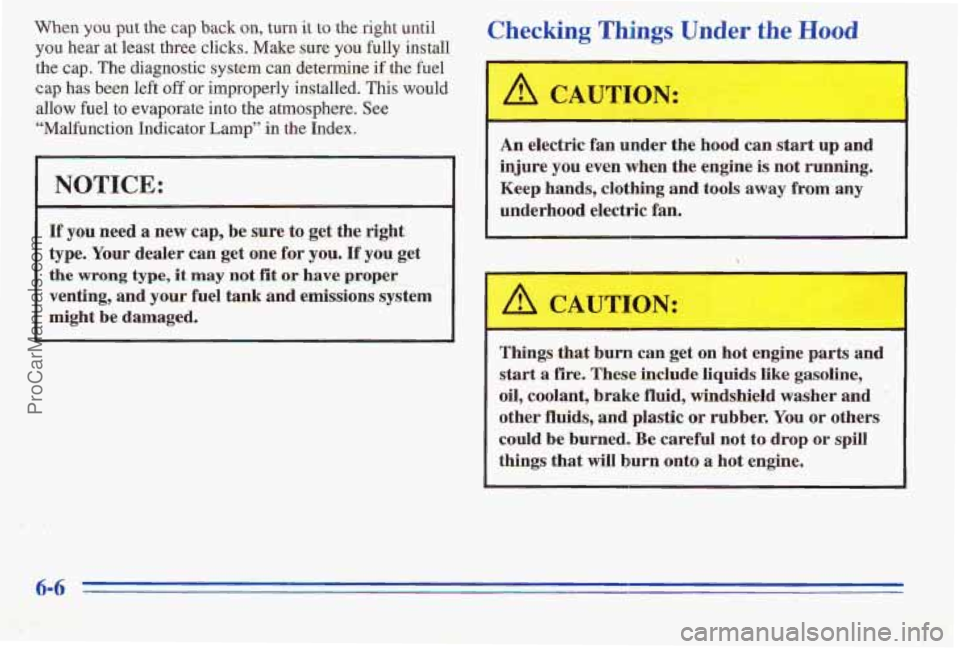Page 34 of 370

When should an air bag inflate?
The’ air bag is designed to inflate in moderate to severe
frontal or near-frontal crashes. The air bag will inflate
only if the impact speed
is above the system’s designed
“threshold level.” If your vehicle goes straight into a
wall that doesn’t move or deform, the threshold level is
about
9 to 15 mph (14 to 24 km/h). The threshold level
can
vary, however, with specific vehicle design, so that
it can be somewhat above or below this range. If your
vehicle strikes something that will move or deform, such
as a parked car, the threshold level will be higher. The
air bag is not designed to inflate in rollovers, side
impacts or rear impagts,
., - .because. iflation. would not
help the occupant.
. In any particular crash, no one can say whether an air
bag
should have inflated simply because of the damage
to a vehicle or because
of what the repair costs were.
Inflation is determined by the angle of the impact and
the vehicle’s deceleration. Vehicle damage is only one
indication of this.
., -: .. ,
., t: _,
.
What makes an air bag inflate?
In a frontal or near-frontal impact of sufficient severity,
the air bag sensing system detects that the vehcle
is
suddenly stopping as a result of a crash. The sensing
system triggers a chemical reaction of
the sodium azide
sealed in the inflator. The reaction produces nitrogen
gas, which inflates the air bag. The inflator, air bag and
related hardware are all part of the air bag modules
p,acked inside the steering wheel and in the instrument
panel
in front of the right front passenger.
How does an air bag restrain?
t
In moderate to severe frontal or near-frontal collisions,
even belted occupants can contact
the steering.whee1 or the
instrument panel. The
air bag supplements the protection
provided
by safety belts. Air bags distribute the force of
the impact more evenly over the occupant’s upper body,
stopping the occupant more gradually. But
air bags would
not help
you in many types of collisions, including
rollovers, rear impacts and side impacts, primarily because
an occupant’s motion’is not toward the air bag. Air
bags should never be regarded as anything more than
a supplement
to safety belts, and then only in moderate
to severe frontal or near-frontal collisions.
ProCarManuals.com
Page 230 of 370

If your vehicle is certified to meet California Emission
Standards (indicated on the underhood tune-up label),
it is designed to operate on fuels that meet California
specifications. If such fuels are not available in states
adopting California emissions standards, your vehicle
will operate satisfactorily on fuels meeting federal
specifications, but emission control system performapce
may be affected. The malfunction indicator lamp on
your instrument panel may
turn on and/or your vehicle
may fail a smog-check test. If this occurs, return to your
authorized Pontiac dealer for diagnosis to determine the
cause of failure. In the event it is determined that the
cause of the condition
is the type of fuels used, repairs
may not be covered by your warranty.
In Canada, some gasolines contain an octane enhancing
additive called MMT. If you use such fuels, your
emission control system performance may deteriorate
and the malfunction indicator lamp on your instrument
panel may turn on. If this happens, return to your
authorized Pontiac dealer for service. and ethanol, and reformulated gasolines
may
be
available in your area to help clean the air. General
Motors recommends that you use these gasolines if they
comply with the specifications described earlier.
NOTICE:
Your vehicle was not designed for fuel that
contains methanol. Don’t use it. It can corrode
metal parts in your fuel system and also damage
plastic and rubber parts. That damage wouldn’t
be covered under your warranty.
To provide cleaner air, all gasolines are now required to
contain additives that will help prevent deposits from
forming in your engine
and fuel system, allowing your
emission control system to function properly. Therefore,
you should not have to add anything to the fuel. In
addition, gasolines containing oxygenates, such as ethers
6-3
ProCarManuals.com
Page 233 of 370

When you put the cap back on, turn it to the right until
you hear at least three clicks. Make sure you €ully install
the cap. The diagnostic system can determine if the fuel
cap has been left off or improperly installed. This would
allow he1 to evaporate into the atmosphere. See
"Malfunction Indicator
Lamp" in the Index.
NOTICE:
I€ you need a new cap, be sue to get the right
type. Your dealer can get one for
you. If you get
the wrong type, it may not fit or have proper
venting, and
your fuel t&-@nd gmissions system
might be damaged. . ...._ ,. . 4.~*,-.:~7F4c:> i,,:;:r'.&:;.., I 5 .v,<. " 52;:. .' , "" $g7!fnt ,,
Checking Things Under the Hood
An electric fan under the hood can start up and
injure
YOU even when the engine is not running.
Keep hands, clothing and tools away from any
underhood electric fan.
Things
that burn can get on hot engine parts and
start a fire. These include liquids like gasoline,
oil, coolant, brake fluid, windshield washer and "
other fluids, and plastic or rubber. You or others
could
be burned. Be careful not to drop or spill
things
that will burn onto a hot engine.
~ ~~~
ProCarManuals.com
Page 258 of 370
Bulb Replacement
In this section you'll find directions for changing the
bulbs in some of the lamps on your Pontiac. See
"Replacement Bulbs" in the Index
to find the type of
bulb you should use.
Halogen Bulbs
I
I /r CAUTION:
Halogen bulbs have pressurized gas inside and
can burst if you drop or scratch the bulb. You or
others could be injured. Be sure to read and
follow the instructions on the bulb package.
Headlamps (2-Door Models)
1. Open the headlamp panel.
I 6-31
ProCarManuals.com